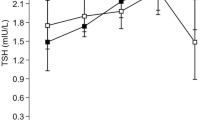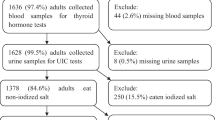Abstract
This study was performed to investigate the status of iodine intake among the Kuwaiti population and its effect on thyroid function. The study group was comprised of 139 females and 86 males with a mean age of 33 and 35 years, respectively. Urinary iodine excretion (UIE) and serum free T4 (FT4), thyrotropin hormone (TSH), antiperoxidase antibodies (anti-TPOAb), and antithyroglobulin antibodies (anti-TGAb) were determined. Median UIE was 148 µg/L (within the recommended level by the World Health Organization [WHO]). However, UIE levels of <100 and <50 µg/L were detected in both male and female groups, respectively. Serum levels of TSH and FT4 were normal for all except one of the participants who suffered from hyperthyroidism, possibly as a result of elevated iodine intake, which was reflected in an increased UIE of 590 µg/L. Elevated anti-TPOAb >75 IU/mL and anti-TGAb >150 IU/mL were detected in 15% and 34% of subjects; only 10% of them had elevated levels of both anti-TPOAb and anti-TGAb. Thus, based on the WHO recommendations, the iodine intake for the Kuwaiti population is adequate. However, it is recommended that a national study be conducted by the appropriate authority in order to eliminate any artifacts which may have appeared in this study.

Similar content being viewed by others
References
Clugston GA, Hetzel BS (1994) Iodine. In: Hils ME, Olson JA, Shike M (eds) Modern nutrition in health and disease, 8th edn. Lea & Febig, Philadelphia, pp 252–263
Dunn JT, Delange F (2001) Damaged reproduction: the most important consequence of iodine deficiency. J Clin Endocrinol Metab 86:2360–2363
Hollowell JG, Staehling NW, Hannon WH et al (1998) Iodine nutrition in the United States. Trends and public health implications: iodine excretion data from National Health and Nutrition Examination Surveys I and III (1971–1974 and 1988–1994). J Clin Endocrinol Metab 83:3401–3408
Hollowell JG, Staehling NW, Flanders WD et al (2002) Serum TSH, T4, and thyroid antibodies in the United States population (1988 to 1994): National Health and Nutrition Examination Survey (NHANES III). J Clin Endocrinol Metab 87:489–499
de Benoist B, Andersson M, Takkouche B, Egli I (2003) Prevalence of iodine deficiency worldwide. Lancet 362:1859–1860
Delange F, de Benoist B, Pretell E, Dunn JT (2001) Iodine deficiency in the world: where do we stand at the turn of the century? Thyroid 11:437–447
Boyages SC (1993) Iodine deficiency disorders. J Clin Endocrinol Metab 77:587–591
Li M, Eastman CJ, Waite KV et al (2006) Are Australian children iodine deficient? Results of the Australian National Iodine Nutrition Study. Med J Aust 184:165–169
Vitti P, Delange F, Pinchera A, Zimmermann M, Dunn JT (2003) Europe is iodine deficient. Lancet 361:1226–1229
Haldimann M, Eastgate A, Zimmerli B (2000) Improved measurement of iodine in food samples using inductively coupled plasma isotope dilution mass spectrometry. Analyst 125:1977–1982
World Health Organization (WHO)/United Nations Children's Fund (UNICEF)/International Council for Control of Iodine Deficiency Disorders (ICCIDD) (2001) Assessment of the iodine deficiency disorders and monitoring their elimination. Report of Consultation, 4–6 May 1999; A Guide for Programme Managers, 2nd ed. WHO/NHD 01.1. Geneva
Andersen S, Pedersen KM, Pedersen IB, Laurberg P (2001) Variations in urinary iodine excretion and thyroid function. A 1-year study in healthy men. Eur J Endocrinol 144:461–465
World Health Organization (WHO)/United Nations Children's Fund (UNICEF)/International Council for Control of Iodine Deficiency Disorders (ICCIDD) (1995) Indicators for assessing iodine deficiency disorders and their control through salt iodization. WHO/NUT/94.6, Geneva, pp 1–155
Delange FM (2002) Iodine deficiency. In: Braveman LE, Utiger RD (eds) Werner and Ingbar's the thyroid: a fundamental and clinical text, 8th edn. Lippincott Williams & Wilkins Philadelphia, pp 295–316
Moosa K, Abdul Wahab AW, Al-Sayyad J, Baig BZ (2001) National study on the prevalence of iodine deficiency disorders among schoolchildren 8–12 years of age in Bahrain. East Mediterr Health J 7:609–616
Azizi F, Malik M, Bebars E, Delshad H, Bakir A (2003) Thyroid volumes in schoolchildren of the Emirates. J Endocrinol Invest 26:56–60
Abu-Eshy SA, Abolfotouh MA, Al-Naggar YM (2001) Endemic goitre in schoolchildren in high and low altitude areas of Asir region, Saudi Arabia. Saudi Med J 22:146–149
Pedersen KM, Iversen E, Laurberg P (1995) Urinary iodine excretion and individual iodine supplementation among elderly subjects: a cross-sectional investigation in the commune of Randers, Denmark. Eur J Endocrinol 132:171–174
Manz F, Bohmer T, Gartner R, Grossklaus R, Klett M, Schneider R (2002) Quantification of iodine supply: representative data on intake and urinary excretion of iodine from the German population in1996. Ann Nutr Metab 46:128–138
Gruning T, Zophel K, Wunderlich G, Franke WG (2001) Prevalence of goiter and iodine deficiency in Saxony is less than previously assumed. A study 6 years after discontinuation of general iodization of table salt. Med Klin 96:1–8
Brauer VF, Brauer WH, Führer D, Paschke R (2005) Iodine nutrition, nodular thyroid disease, and urinary iodine excretion in a German university study population. Thyroid 15:364–370
Soldin OP, Soldin SJ, Pezzullo JC (2003) Urinary iodine percentile ranges in the United States. Clin Chim Acta 328:185–190
Carlé A, Laurberg B, Knudsen N, Perrild H, Ovesen L, Rasmussen LB et al (2006) Thyroid peroxidase and thyroglobulin auto-antibodies in patients with newly diagnosed overt hypothyroidism. Autoimmunity 39:497–503
Othman G, Baidas G (2004) Incidence of primary hypothyroidism due to chronic thyroiditis in Kuwait: iodine deficiency disorders. Proceedings of the Third Kuwaiti Society for Endocrinology Conference
Hasanat MA, Rumi MA, Alam MN, Ahmed S, Hasan KN, Khan AY et al (2004) Urinary iodine status and thyroid dysfunction: a Bangladesh perspective. Bangladesh Med Res Counc Bull 30:16–24
Mazziotti G, Premawardhana LD, Parkes AB, Adams H, Smyth PP, Smith DF et al (2003) Evolution of thyroid autoimmunity during iodine prophylaxis—the Sri Lankan experience. Eur J Endocrinol 149:103–110
Teng W, Shan Z, Teng X, Guan H, Li Y, Teng D et al (2006) Effect of iodine intake on thyroid diseases in China. N Engl J Med 354:2783–2793
Camargo RY, Tomimori EK, Neves SC, Rubio GS I, Galrão AL, Knobel M (2008) Thyroid and the environment: exposure to excessive nutritional iodine increases the prevalence of thyroid disorders in São Paulo, Brazil. Eur J Endocrinol 159:293–299
Papanastasiou L, Vatalas IA, Koutras DA, Mastorakos G (2007) Thyroid autoimmunity in the current iodine environment. Thyroid 7:729–739
Prummel MF, Strieder T, Wiersinga WM (2004) The environment and autoimmune thyroid diseases. Eur J Endocrinol 150:605–618
Benmiloud M, Chauki ML, Gutekunst R, Teichert HM, Graham W, Dunn JT (1994) Oral iodized oil for correcting iodine deficiency: optimal dosing and outcome indicator selection. J Clin Endocrinol Metab 79:20–24
Zimmermann MB, Moretti D, Chaouki N, Torresani T (2003) Introduction of iodized salt to severely iodine-deficient children does not provoke thyroid autoimmunity: a one-year prospective trial in northern morocco. Thyroid 13:199–203
Safran M, Paul TL, Roti E, Braverman LE (1987) Environmental factors affecting autoimmune thyroid disease. Endocrinol Metab Clin North Am 16:327–342
Konno N, Iizuka N, Kawasaki K, Taguchi H, Miura K, Taguchi S et al (1994) Screening for thyroid dysfunction in adults residing in Hokkaido Japan: in relation to urinary iodide concentration and thyroid autoantibodies. Hokkaido Igaku Zasshi 69:614–626
Zeitlin AA, Simmonds MJ, Gough SC (2008) Genetic developments in autoimmune thyroid disease: an evolutionary process. Clin Endocrinol 68:671–82
Abelitz M, Liesenkotter KP, Stach B, Willgerodt H, Stablein W, Singendonk W et al (2003) The prevalence of anti-thyroid peroxidase antibodies and autoimmune thyroiditis in children and adolescents in an iodine replete area. Eur J Endocrinol 148:301–307
Moussa MA, Alsaeid M, Refai TM, Abdella N, Al-Sheikh N, Gomez JE (2005) Factors associated with type 1 diabetes in Kuwaiti children. Acta Diabetol 42:129–137
Shaltout AA, Moussa MA, Qabazard M, Abdella N, Karvonen M, Al-Khawari M et al (2002) Kuwait Diabetes Study Group: further evidence for the rising incidence of childhood type 1 diabetes in Kuwait. Diabet Med 19:522–525
Kordonouri O, Hartmann R, Deiss D, Wilms M, Grüters-Kieslich A (2005) Natural course of autoimmune thyroiditis in type 1 diabetes: association with gender, age, diabetes duration, and puberty. Arch Dis Child 90:411–414
Bu-Olayan AH, Subrahmanyam MN (1997) Accumulation of copper, nickel, lead and zinc by snail, Lunella coronatus and pearl oyster, Pinctada radiata from the Kuwait coast before and after the Gulf War oil spill. Sci Total Environ 197:161–165
Al-Mohanna SY, Subrahmanyam MN (2001) Flux of heavy metal accumulation in various organs of the intertidal marine blue crab, Portunus pelagicus (L.) from the Kuwait coast after the Gulf War. Environ Int 27:321–326
Bouhamra WS (1995) Estimation of volatile organic compounds in Kuwaiti houses after the Gulf war. Environ Pollut 90:121–125
Author information
Authors and Affiliations
Corresponding author
Rights and permissions
About this article
Cite this article
Al-Yatama, F.I., Al-Bader, M.D., Al-Mazidi, Z.M. et al. Assessment of Urinary Iodine Excretion Among Normal Kuwaiti Adults. Biol Trace Elem Res 132, 67–74 (2009). https://doi.org/10.1007/s12011-009-8398-6
Received:
Accepted:
Published:
Issue Date:
DOI: https://doi.org/10.1007/s12011-009-8398-6




